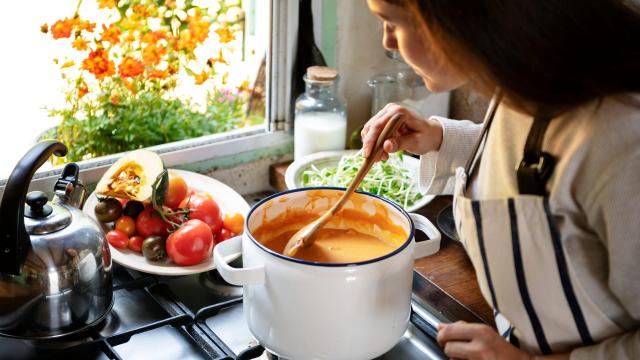Many years ago, I saw — or at least I think I saw — an article that claimed stirring a pot of food using straight, back-and-forth motions was more effective than stirring in circles. I cannot find the original article I either saw or imagined, but at least one other person also saw or imagined this particular piece of food writing.
Whether real or dreamed, the article affected my stirring. I usually stir in straight lines, moving back and forth across the pan or pot, with occasional circular swoops around the sides to make sure nothing gets trapped on the edges.
But which way is truly more effective, and does it make that big of a difference? Back and forth straight lines always seemed more efficient to me — you cover more of the pan, rather than push food around the perimeter — but I’ve never gotten super science-y about it (because I’ve never cared for physics).
Luckily, the people at Cook’s Illustrated do care for my least favourite discipline. According to them, stirring side-to-side is much more effective, with one notable exception (which we will get to in a moment). The method testers emulsified vinaigrettes, and whipped cream and egg whites to see which movement incorporated ingredients quickly and efficiently:
In all cases, side-to-side whisking was highly effective. It kept the vinaigrette (made simply of oil and vinegar) fully emulsified for 15 minutes, and it speedily whipped cream to stiff peaks in 4 minutes and egg whites to stiff peaks in 5 minutes. Circular stirring was ineffectual across the board. It never fully emulsified the dressing, which remained thin and separated, and it took more than twice as long as side-to-side whisking to whip cream and egg whites (10 and 12 minutes, respectively).
There are two main reasons for this: Moving one’s hand back and forth is easier than moving it in circles, so you can mix harder for longer, but it also produces more shear force:
As the whisk moves in one direction across the bowl, the liquid starts to move with it. But then the whisk is dragged in the opposite direction, exerting force against the rest of the liquid still moving toward it. Because stirring and beating take the liquid in the same direction of the whisk, they produce less shear force.
Sheer force is also why slamming vinaigrette ingredients back in forth in a sealed container creates a more stable emulsification than whisking, but the benefits of side-to-side stirring can even be seen in less dramatic applications, like sauces, soups, and stews. (Plus, the back-and-forth motion ensures the spoon comes in contact with more of the pot or pan, preventing food from sticking and/or burning.)
The only food that doesn’t benefit from the ol’ back-and-forth is egg whites, due to their unique viscosity:
Because egg whites are very viscous, more of them will cling to the tines than cream, even at the beginning of whipping. This allows the whisk to create wider channels that trap more air. With side-to-side strokes, the reverse motion will disrupt some of the channels that were just created, slowing the process of trapping air and building volume. Since beating takes the whisk out of the liquid during some of its action, these larger channels can stay open longer, trapping more air. In this case, the effect is more important than shear force in quickly creating volume.
So beat your egg whites with circular movements, but move side to side with everything else. Your dressings, sauces, and whipped dairy will be the better for it.

Leave a Reply
You must be logged in to post a comment.